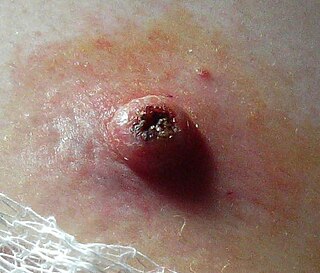Related Research Articles

Keratoacanthoma (KA) is a common low-grade rapidly-growing skin tumour that is believed to originate from the hair follicle and can resemble squamous cell carcinoma.

Prurigo nodularis (PN), also known as nodular prurigo, is a skin disorder characterized by pruritic (itchy), nodular lesions, which commonly appear on the trunk, arms and legs. Patients often present with multiple excoriated nodules caused by chronic scratching. Although the exact cause of PN is unknown, PN is associated with other dermatologic conditions such as untreated or severe atopic dermatitis and systemic causes of pruritus including liver disease and end stage kidney disease. The goal of treatment in PN is to decrease itching. PN is also known as Hyde prurigo nodularis, or Picker's nodules.
Papular mucinosis is a rare skin disease. Localized and disseminated cases are called papular mucinosis or lichen myxedematosus while generalized, confluent papular forms with sclerosis are called scleromyxedema. Frequently, all three forms are regarded as papular mucinosis. However, some authors restrict it to only mild cases. Another form, acral persistent papular mucinosis is regarded as a separate entity.
Lupus erythematosus panniculitis presents with subcutaneous nodules that are commonly firm, sharply defined and nontender.

Generalized essential telangiectasia, also known as general essential telangiectasia, is characterized by the dilation of veins and capillaries over a large segment of the body without preceding or coexisting lesions, telengiectases that may be distributed over the entire body or be localized to some large area such as the legs, arms, or trunk.

Erythrokeratodermia variabilis is a rare autosomal dominant disorder that usually presents at birth or during the first year of life. To date, it is thought to be caused by mutations in genes encoding for connexin channels proteins in the epidermis, leading to the misregulation of homeostasis in keratinocytes.
Glomeruloid hemangioma is a distinctive vascular tumor first described in 1990 when found to be associated with POEMS syndrome and Castleman disease. Glomeruloid hemangiomas can manifest as wine-red sessile or pedunculated papules, papulonodules, subcutaneous bluish compressible tumors, or small, firm, reddish-violaceous, dome-shaped papules.
Trichorrhexis invaginata is a distinctive hair shaft abnormality that may occur sporadically, either in normal hair or with other hair shaft abnormalities, or regularly as a marker for Netherton syndrome. The primary defect appears to be abnormal keratinization of the hair shaft in the keratogenous zone, allowing for intussusception of the fully keratinized and hard distal shaft into the incompletely keratinized and soft proximal portion of the shaft.

Leishmania tropica is a flagellate parasite and the cause of anthroponotic cutaneous leishmaniasis in humans. This parasite is restricted to Afro-Eurasia and is a common cause of infection in Afghanistan, Iran, Syria, Yemen, Algeria, Morocco, and northern India.
Non-Langerhans cell histiocytosis, also known as rare histiocytoses, comprise all histiocyte, macrophage, and dendritic cell proliferative disorders that are not categorized as hemophagocytic lymphohistiocytosis (HLH) or Langerhans cell histiocytosis (LCH).
Non-X histiocytoses are a clinically well-defined group of cutaneous syndromes characterized by infiltrates of monocytes/macrophages, as opposed to X-type histiocytoses in which the infiltrates contain Langerhans cells. Conditions included in this group are:
Generalized eruptive histiocytoma is a rare cutaneous condition characterized by widespread, erythematous, essentially symmetrical papules, particularly involving the trunk and proximal extremities.
Progressive nodular histiocytosis is a cutaneous condition clinically characterized by the development of two types of skin lesions: superficial papules and deeper larger subcutaneous nodules. Progressive nodular histiocytosis was first reported in 1978 by Taunton et al. It is a subclass of non-Langerhans cell histiocytosis and a subgroup of xanthogranuloma.
An Apocrine nevus is an extremely rare cutaneous condition that is composed of hyperplastic mature apocrine glands. Apocrine nevi present as a nodular skin-coloured lump. They are typically asymptomatic. Apocrine nevi can be congenital and they have been associated with other disorders.

Polypoid melanoma is a rare cutaneous condition, a virulent variant of nodular melanoma. Polypoid melanoma is a subtype of nodular melanoma, the most aggressive form of melanoma.

Trichoblastomas are a skin condition characterized by benign neoplasms of the follicular germinative cells known as trichoblasts.
A superficial acral fibromyxoma is a type of myxoma and is a rare cutaneous condition characterized by a mesenchymal neoplasm that typically occurs on the digits of middle-aged adults.
Weber–Christian disease is a cutaneous condition characterized by recurrent subcutaneous nodules that heal with depression of the overlying skin.
Nodular lichen myxedematosus is a cutaneous condition characterized by multiple nodules on the limbs and trunk, with a mild or absent papular component.
References
- ↑ Rapini, Ronald P.; Bolognia, Jean L.; Jorizzo, Joseph L. (2007). Dermatology: 2-Volume Set. St. Louis: Mosby. ISBN 978-1-4160-2999-1.